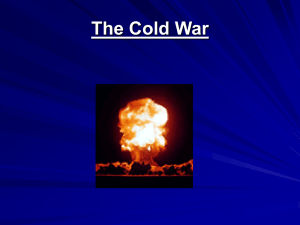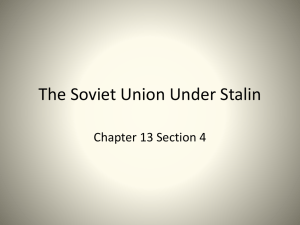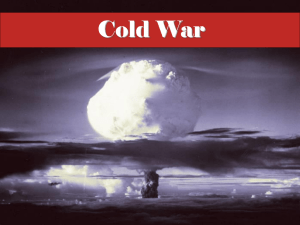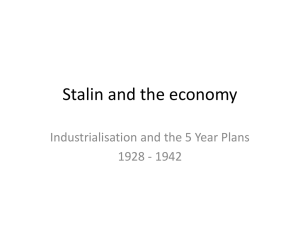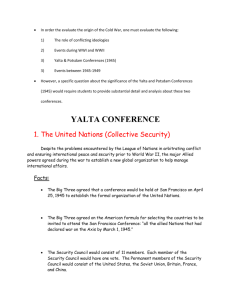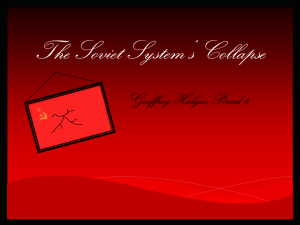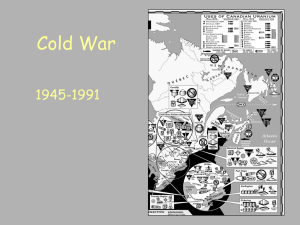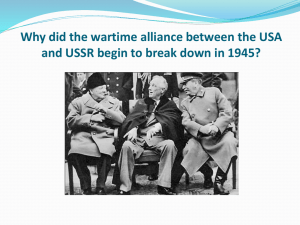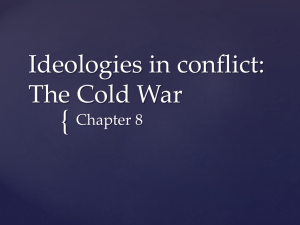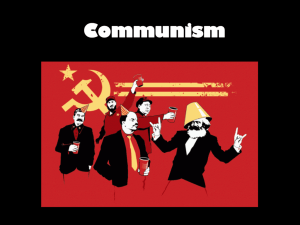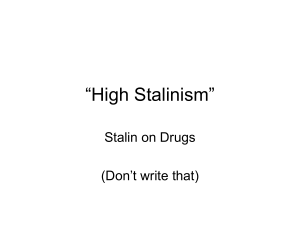What was the Cold War and why did it develop?
advertisement
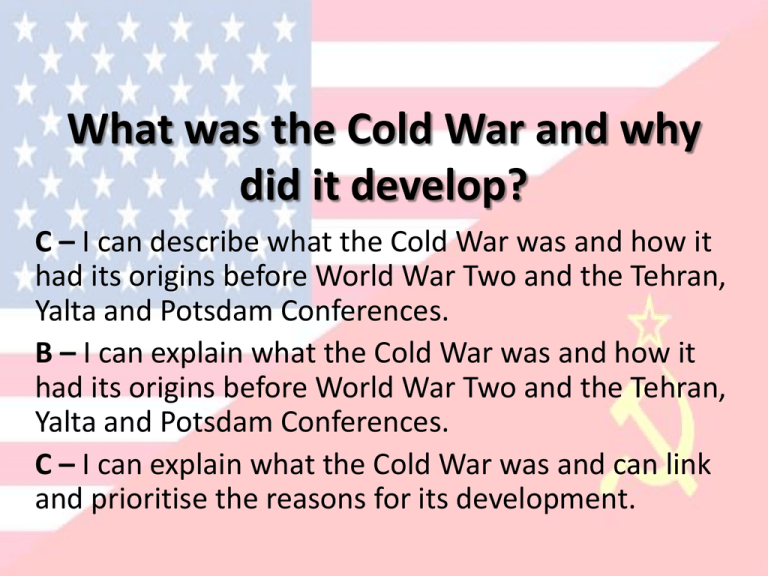
What was the Cold War and why did it develop? C – I can describe what the Cold War was and how it had its origins before World War Two and the Tehran, Yalta and Potsdam Conferences. B – I can explain what the Cold War was and how it had its origins before World War Two and the Tehran, Yalta and Potsdam Conferences. C – I can explain what the Cold War was and can link and prioritise the reasons for its development. What was the Cold War? • • • • USA vs. USSR (Russia) Capitalism vs. Communism West vs. East NATO vs. Warsaw Pact • • • • NOT FIGHTING!! Started 1945/6 Lasted 40 years USA and USSR were the MOST POWERFUL countries in the world after 1945. Britain, Germany, France and Japan all much weaker after fighting WW2. What were the features of the Cold War? • Spying – Spied on each other, particularly each other’s military. Spy planes used, like USA’s U2 plane. • Propaganda – Both sides created the worst possible image of the other to win over public opinion. Sporting success also used as propaganda. • Arms race – Competition over who had most weapons (including Nuclear). Both sides had more than enough weapons to wipe each other out (Mutually Assured Destruction theory). This acted as a deterrant to the Cold War going ‘hot’ (fighting). • Space race – Competition to see who could launch first satellite, put first man in space, put first man on moon. Effective propaganda. • Loans and aid – Both sides provided loans and aid to newly less developed countries to try to win their support. How did the Cold War rivalry originate? • Capitalism vs. Communism • Russia became Communist in 1917 after the Bolshevik revolution. • Capitalism and Communism were opposing political theories. Caused tension. Capitalism Communism Politics – many political parties. Elected governments. Economy – Privately owned business and big differences between rich and poor. Politics – Just the Communist Party. No genuinely elected governments. Economy – Industry owned by the government. Equality between rich and poor. Beliefs – Everyone equal. Believe in encouraging World Revolution to turn world communist. Beliefs – Little media censorship. Acceptance of differences between rich and poor. Why did rivalry deepen before WW2? • Hitler – Hitler openly hated Communism. Stalin believed Britain, France and USA would ally with Hitler against USSR. • Nazi-Soviet Pact – Signed in 1939 by Hitler and Stalin. Britain, France and USA hated Stalin and USSR even more. Why did the rivalry develop during World War 2? • Spying – Spied on each other, particularly each other’s military. Spy planes used, like USA’s U2 plane. • Propaganda – Both sides created the worst possible image of the other to win over public opinion. Sporting success also used as propaganda. • Arms race – Competition over who had most weapons (including Nuclear). Both sides had more than enough weapons to wipe each other out (Mutually Assured Destruction theory). This acted as a deterrant to the Cold War going ‘hot’ (fighting). • Space race – Competition to see who could launch first satellite, put first man in space, put first man on moon. Effective propaganda. • Loans and aid – Both sides provided loans and aid to newly less developed countries to try to win their support. Tehran: Where: Tehran, capital city of Iran. When: November 1943. Who: Stalin (USSR), Roosevelt (USA), Churchill (GB) What was agreed: • Britain and USA agreed to open up a ‘second front’ in the war • USSR agreed to fight with the USA against Japan. • United Nations. • Stalin secured agreement that a section of Poland would become part of the Soviet Union. Tehran – Strains Starting to Show • Second front - Stalin was frustrated that the US and GB delayed opening up a second front. Soviet damage! • Churchill - Churchill was suspicious of Stalin and him spreading communism. • Poland –Stalin had clearly set his sights on controlling Poland. • Warsaw Uprisi ng – Soviet forces they failed to intervene and support the Polish uprising in Warsaw and let the Germans brutally crush the Polish rebels. Yalta: Where: Yalta, Ukraine When: February 1945 Who: Stalin (USSR), Roosevelt (USA), Churchill (GB) What was agreed: • USSR would fight Japan • 4 zones: Germany and Berlin • Nazi war criminals to be punished • Free elections for liberated countries. • Confirmed set up of UN. • Eastern Europe would be created as a Soviet sphere of influence. Yalta – Strains starting to show • Reparations: Stalin wanted Germany to pay higher reparations that US and GB wanted. No decision was made. • Poland: Stalin wanted to take much more Polish land than GB and the USA wanted to allow. He also wanted a ‘friendly’ Polish government. The western powers feared this would be a Soviet controlled government. Stalin was persuaded to allow free elections in Poland. Potsdam Where: Potsdam, Germany When: July 1945 Who: Stalin (USSR), Truman (USA ) and Attlee (GB) Events before conference: • Soviet Troops liberated countries in Eastern Europe and then left soldiers in each country (Latvia, Lithuania, Estonia, Finland, Czechoslovakia, Hungary, Bulgaria and Romania). • Stalin set up a Communist government in Poland, ignoring the wishes of most Poles and the protests of GB and USA. • Soviet Union continued to expand armed forces. • Truman replaced Roosevelt after his death. • USA successfully tested the A-Bomb. • Churchill defeated in 1945 General Election in GB. Potsdam What was agreed: • Germany and Berlin to be divided as agreed at Yalta. • Germany to be demilitarised. • Hold free elections in Germany. • Germany to pay reparations in equipment and materials, most to the Soviet Union. • Nazi Party banned and leading Nazis put on trial. • UN set up. • Poland’s frontier with USSR moved West. Potsdam - Disagreements • Stalin wanted to crush Germany. Truman disagreed. • Free elections: Truman wanted free elections in Eastern European countries occupied by Soviet Troops. Stalin refused to listen. • Truman ‘gets tough’. Who was to blame? Soviet Union to blame - Determined to spread communism to other countries. - Refused to allow free elections to ensure communist governments were set up. BUT: Russia had twice been invaded by Germany and had suffered enormous losses. Soviet Union wanted to create a buffer against Germany. Stalin feared the USA’s Atom Bomb. USA to blame Both to blame - Didn’t understand the - The Cold War was down to a suffering the Soviet Union lack of trust between the had endured. two countries. - Used the Atom Bomb to - Both sides overreacted and threaten the Soviet Union. were overly aggressive. - USA only concerned about furthering there own interests in Eastern Europe. BUT America genuinely wanted to see free elections in Europe. America had learned the lesson of treating Germany too harshly at Verailles. Questions 1. Describe one decision made at the Tehran conference . (2 marks, 2 minutes, POINT EXPLANATION) 2. Briefly explain the events of the Yalta conference. (6 marks, 8 minutes, POINT EXPLANATION X3) 3. Briefly explain what was agreed at the Potsdam conference. (6 marks, 8 minutes, POINT EXPLANATION X3) 4. Describe one area of disagreement between the Soviet Union and the USA at Potsdam. (2 marks, 2 minutes, POINT EXPLANATION) 5. Explain why relations between the Soviet Union and the USA grew worse, 1943 – 1945. (12 marks, 15 minutes, POINT EXPLANATION LINK X3, CONCLUSION)
